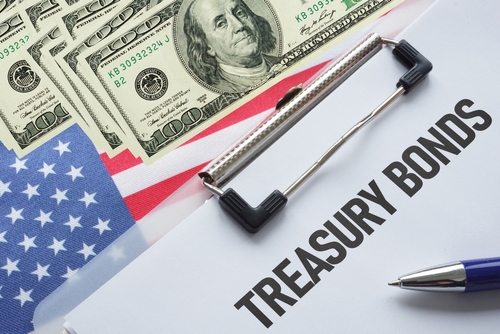This site uses cookies to provide you with a great user experience. By using BondbloX, you accept our use of cookies.
Bond Market News
How to Buy US Treasuries – In 4 Simple Steps
July 7, 2025

Introduction
Warren Buffett‘s will has instructed his trustee to invest 10 percent in short-dated government bonds and the rest in a low cost S&P 500 index fund. Buffett said, “I laid out what I thought the average person who is not an expert on stocks should do. And my widow will not be an expert on stocks. I want to be sure she gets a decent result… Put 10% of the cash in short-term government bonds…” The strategy Buffett outlined is not just for his family but applies to any investor seeking reliable returns without the need for expert knowledge. He advised using the 10 percent allocation in short-term government bonds as a buffer during market downturns, allowing for withdrawals without needing to sell stocks at potentially low prices.
The remainder of this article is about the mechanics of buying government bonds, how easy it is and how to do it in a low-cost manner, just like Warren advises on the S&P 500. This article is not investment advice and readers are further cautioned that the long-dated government bonds, for example the US 30 year can drop in value sharply in a rising interest rate environment. Shorter-dated government paper (T-bills) on the other hand are much more stable with the price going towards 100 as it approaches maturity. These short-dated papers (another word for bonds, reminiscent from the days of paper bonds) are anchored towards the overnight rates which are relatively stable. Intuitively, it is easier to predict the state of an economy over the next 12 months than it is over the next 30 years.

I have never bought US Treasuries – what do I need to know and do?
Most people don’t buy treasuries because they simply don’t have access to buying treasuries! Treasuries are also not actively sold by bankers, just like term life insurance is rarely sold. The fees for the banks are simply not attractive enough. The second reason is that you need a securities account to buy US treasuries which used to be tough to open. Another reason is the US tax forms, the W8 Ben or equivalent, which permits eligible investors to receive the full coupon without any withholding taxes.
The last thing is that it is not super cool to espouse the virtue of US T bills at a cocktail party where everyone is bragging about their super cool investments into AI stocks, crypto coins and private debt! They are “risk-free” and thus they promise to pay lower than everyone else! But they do certianly pay. The way to think about government bonds is as an alternative to money in a savings account yielding zero.
Things are changing. The recent increase in yields is triggering a retail bond buying revolution!
Today with platforms like BondbloX it is super easy to onboard, get a securities account and start the US treasury buying journey – it really only takes a few minutes. Even filling up the tax forms is quick and fully digital. In one go everything is set up, from your trading account to custody as well as tax forms.
-png.png)
Ok – so it’s easy to buy now, but what about the costs?
The difference between the price at which you can buy and the price at which you can sell is called the bid-offer spread. The smaller the difference between the buy and sell price, the better or more efficient the market. The liquid 10-year US treasury is among the most liquid asset in the world.
Today the BondbloX exchange was seeing a price of the 4% US Treasury maturing in December 2027 of 100.368 (buy) and 100.319 (sell).

That’s a difference of just 0.049
Simply put, for an investment of a million dollars the bid-offer is a four hundred ninety dollars – that is a very tight spread. For a corporate bond, the spread is substantially higher, say 0.50 (50 bps) or even 1.00 ( 100 bps) which runs into the thousands
Round trip transaction cost is a related concept where you add the fees or commission on top as well. On the BondbloX platform, treasuries have a super low fee of only 0.05% (5 bps). So, on a $1,000 trade you pay 50 cents (not even a dollar) in fees. Some platforms (not BondbloX) may charge a minimum fee like $5.
If you are an investor who trades and takes views on the markets, it is critical to have low round trip costs. It is pointless to see your profits being eroded or eliminated by trading costs. Even if you don’t intend to trade, having low round trip costs improves your return and is important to keep in mind.
Got it – any other benefits of investing in Treasuries?
– Investment in any portfolio, needs diversification, mostly low risk and some medium and high risk. Bonds are essentially the low risk base of the pyramid. How much of allocation to bonds depends on investor preferences, age, wealth etc. Even at a 10 percent allocation, Mr. Buffett’s wife would have plenty invested in bonds. Investing in government bonds denominated in their local currency represent a risk-free investment, more precisely credit risk free. They do have inflation risk – if the rate of inflation is higher than the bond yield, the investment will erode in value. They also have mark to market risk, particularly in longer tenor bonds. But they don’t have credit risk. So, if you invest in government bonds denominated in their local currency, you will get your money back.
– Since US government bonds come in small denominations, you can also use them for building bond ladders. Read about how to use bond ladders to find stable income here. Let us say your daughter will go to the US to study from 2035-2038. You can buy bonds of these maturities (2035, 2036, 2037, 2038) so that you have the requisite amounts, say USD 50,000, for each year in 2035 through 2038.
– Treasury bonds can also give better returns on idle cash than a typical savings accounts, in addition to serving the purpose of a fallback during times of crises as suggested by Warren Buffet.
Hmmm… won’t bond prices also crash in a crisis?
Everything goes down, 2 Year Treasury goes up
In times of real financial crisis (Covid, GFC of 2008, LTCM…if I keep going back I will reveal my age, but you get the meaning of “real”), every financial asset falls in value, including equity, real estate, corporate bonds. The only thing that goes up is the two-year treasury. When people sell assets, they need something to buy and it’s the treasury that they typically purchase.
See the table below which shows the 30-day movement in the two-year treasury from the start of the crises vs. the S&P.

As Mr. Buffett said in his interview, the treasury allocation avoids the need to sell stocks at low prices.
Conclusion
Ability and desire are two different things. The ability to buy US treasuries is an important tool in the arsenal of investment strategies and it must be ready. Market risk and opportunities come suddenly, it is best to be prepared. So please go and onboard to buy your first government bond that will pay you more than cash left overnight in your bank account. If you don’t have the desire to hold the bonds, you can simply sell them and experience the ease of selling as well.
Go back to Latest bond Market News
Related Posts:
High-Yield Bonds Lead The July Recovery
August 6, 2018

Bond Yields – Explained
December 26, 2024

What to Look for When Buying Bonds
December 4, 2024






